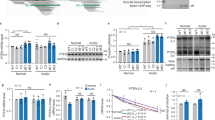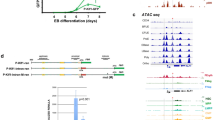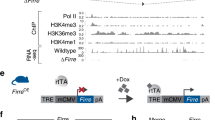Abstract
A more complete understanding of the transcriptional control of the human and murine class I MHC receptors will help to shed light on the mechanism of selective, stochastic, gene activation that operates in these gene families. Studies of the murine Ly49 class I MHC receptor genes have revealed an important role for distal transcripts originating upstream of the proximal promoter. To date, there have been no reports of distal promoters within the functionally analogous human KIR family of class I MHC receptors. In the current study, reverse transcriptase-polymerase chain reaction (RT-PCR) and RNase protection assays were used to reveal the presence of distal KIR transcripts initiating upstream of the previously characterized proximal KIR promoter. The intergenic promoter elements detected were associated with repetitive elements of the Alu and L1 families. Unlike the proximal KIR promoter, the distal promoter regions were not NK cell-specific. KIR genes expressed in a variegated manner produced a low level of distal transcripts containing a large 5′ untranslated region. In contrast, the highly expressed KIR2DL4 gene possessed a higher level of spliced distal transcripts that were capable of producing KIR2DL4 protein. The identification of distal KIR promoter elements suggests that intergenic transcripts may influence the expression of KIR genes.
This is a preview of subscription content, access via your institution
Access options
Subscribe to this journal
Receive 6 digital issues and online access to articles
$119.00 per year
only $19.83 per issue
Buy this article
- Purchase on Springer Link
- Instant access to full article PDF
Prices may be subject to local taxes which are calculated during checkout






Similar content being viewed by others
Accession codes
References
Trinchieri G . Biology of natural killer cells. Adv Immunol 1989; 47: 187–376.
Lanier LL . NK cell recognition. Annu Rev Immunol 2005; 23: 225–274.
Carrington M, Norman P . The KIR Gene Cluster. National Library of Medicine (US), NCBI: Bethesda, MD, 2001.
Parham P . MHC class I molecules and KIRs in human history, health and survival. Nat Rev Immunol 2005; 5: 201–214.
Ciccone E, Pende D, Viale O, Di Donato C, Tripodi G, Orengo AM et al. Evidence of a natural killer (NK) cell repertoire for (allo) antigen recognition: definition of five distinct NK-determined allospecificities in humans. J Exp Med 1992; 175: 709–718.
Wagtmann N, Biassoni R, Cantoni C, Verdiani S, Malnati MS, Vitale M et al. Molecular clones of the p58 NK cell receptor reveal immunoglobulin-related molecules with diversity in both the extra- and intracellular domains. Immunity 1995; 2: 439–449.
Valiante NM, Uhrberg M, Shilling HG, Lienert-Weidenbach K, Arnett KL, D'Andrea A et al. Functionally and structurally distinct NK cell receptor repertoires in the peripheral blood of two human donors. Immunity 1997; 7: 739–751.
Santourlidis S, Trompeter HI, Weinhold S, Eisermann B, Meyer KL, Wernet P et al. Crucial role of DNA methylation in determination of clonally distributed killer cell Ig-like receptor expression patterns in NK cells. J Immunol 2002; 169: 4253–4261.
Chan HW, Kurago ZB, Stewart CA, Wilson MJ, Martin MP, Mace BE et al. DNA methylation maintains allele-specific KIR gene expression in human natural killer cells. J Exp Med 2003; 197: 245–255.
Chan HW, Miller JS, Moore MB, Lutz CT . Epigenetic control of highly homologous killer immunoglobulin-like receptor gene alleles. J Immunol 2005; 175: 5966–5974.
Stewart CA, van Bergen J, Trowsdale J . Different and divergent regulation of the KIR2DL4 and KIR3DL1 promoters. J Immunol 2003; 170: 6073–6081.
Trompeter HI, Gómez-Lozano N, Santourlidis S, Eisermann B, Wernet P, Vilches C et al. Three structurally and functionally divergent kinds of promoters regulate expression of clonally distributed killer cell Ig-like receptors (KIR), of KIR2DL4, and of KIR3DL3. J Immunol 2005; 174: 4135–4143.
van Bergen J, Stewart CA, van den Elsen PJ, Trowsdale J . Structural and functional differences between the promoters of independently expressed killer cell Ig-like receptors. Eur J Immunol 2005; 35: 2191–2199.
Xu J, Vallejo AN, Jiang Y, Weyand CM, Goronzy JJ . Distinct transcriptional control mechanisms of killer immunoglobulin-like receptors in natural killer (NK) and in T cells. J Biol Chem 2005; 280: 24277–24285.
Presnell SR, Zhang L, Ramilo CA, Chan HW, Lutz CT . Functional redundancy of transcription factor-binding sites in the killer cell Ig-like receptor (KIR) gene promoter. Int Immunol 2006; 18: 1221–1232.
Wilson MJ, Torkar A, Haude S, Milne T, Jones D, Sheer S et al. Plasticity in the organization and sequences of human KIR/ILT gene families. Proc Natl Acad Sci USA 2000; 97: 4778–4783.
Vilches C, Gardiner CM, Parham P . Gene structure and promoter variation of expressed and nonexpressed variants of the KIR2DL5 gene. J Immunol 2000; 165: 6416–6421.
Saleh A, Davies GE, Pascal V, Wright PW, Hodge DL, Cho EH et al. Identification of probabilistic transcriptional switches in the Ly49 gene cluster: a eukaryotic mechanism for selective gene activation. Immunity 2004; 21: 55–66.
Radeloff B, Nagler L, Zirra M, Ziegler A, Volz A . Specific amplification of cDNA ends (SPACE): a new tool for the analysis of rare transcripts and its application for the promoter analysis of killer cell receptor genes. DNA Seq 2005; 16: 44–52.
Suzuki Y, Sugano S . Construction of a full-length enriched and a 5′-end enriched cDNA library using the oligo-capping method. Methods Mol Biol 2003; 221: 73–91.
Kikuchi-Maki A, Yusa S, Catina TL, Campbell KS . KIR2DL4 is an IL-2-regulated NK cell receptor that exhibits limited expression in humans but triggers strong IFN-gamma production. J Immunol 2003; 171: 3415–3425.
Rajagopalan S, Bryceson YT, Kuppusamy SP, Geraghty DE, van der Meer A, Joosten I et al. Activation of NK Cells by an Endocytosed Receptor for Soluble HLA-G. PLoS Biol 2006; 4: e9.
May BP, Lippman ZB, Fang Y, Spector DL, Martienssen RA . Differential regulation of strand-specific transcripts from Arabidopsis centromeric satellite repeats. PLoS Genet 2005; 1: e79.
Jones EA, Flavell RA . Distal enhancer elements transcribe intergenic RNA in the IL-10 family gene cluster. J Immunol 2005; 175: 7437–7446.
Rogan DF, Cousins DJ, Santangelo S, Ioannou PA, Antoniou M, Lee TH et al. Analysis of intergenic transcription in the human IL-4/IL-13 gene cluster. Proc Natl Acad Sci USA 2004; 101: 2446–2451.
Haussecker D, Proudfoot NJ . Dicer-dependent turnover of intergenic transcripts from the human beta-globin gene cluster. Mol Cell Biol 2005; 25: 9724–9733.
Tanamachi DM, Moniot DC, Cado D, Liu SD, Hsia JK, Raulet DH . Genomic Ly49A trans-genes: basis of variegated Ly49A gene expression and identification of a critical regulatory element. J Immunol 2004; 172: 1074–1082.
Acknowledgements
This project has been funded in whole or in part with federal funds from the National Cancer Institute and the National Institutes of Health, under contract no. DHHS N01-C0-12400. This research was supported in part by the Intramural Research Program of the NIH, National Cancer Institute, Center for Cancer Research. This work was supported in part by NIH Grant R01 HL55417 (JSM).
The contents of this publication do not necessarily reflect the views or policies of the Department of Health and Human Services, nor does mention of trade names, commercial products, or organizations imply endorsement by the US government.
Author information
Authors and Affiliations
Corresponding author
Rights and permissions
About this article
Cite this article
Stulberg, M., Wright, P., Dang, H. et al. Identification of distal KIR promoters and transcripts. Genes Immun 8, 124–130 (2007). https://doi.org/10.1038/sj.gene.6364363
Received:
Revised:
Accepted:
Published:
Issue Date:
DOI: https://doi.org/10.1038/sj.gene.6364363
Keywords
This article is cited by
-
The KIR2DL1 intermediate upstream element participates in gene activation
Immunogenetics (2023)
-
High-Risk Human Papillomavirus E7 Alters Host DNA Methylome and Represses HLA-E Expression in Human Keratinocytes
Scientific Reports (2017)
-
Analysis of Ly49 gene transcripts in mature NK cells supports a role for the Pro1 element in gene activation, not gene expression
Genes & Immunity (2016)
-
Characterization of KIR intermediate promoters reveals four promoter types associated with distinct expression patterns of KIR subtypes
Genes & Immunity (2016)
-
Probabilistic Bidirectional Promoter Switches: Noncoding RNA Takes Control
Molecular Therapy - Nucleic Acids (2014)



